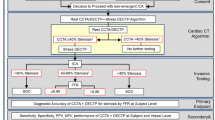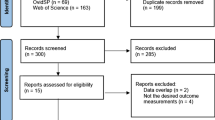Abstract
Objectives
To evaluate patient acceptance of noninvasive imaging tests for detection of coronary artery disease (CAD), including single-photon emission computed tomography myocardial perfusion imaging (SPECT-MPI), stress perfusion magnetic resonance imaging (MRI), coronary CT angiography (CTA) in combination with CT myocardial stress perfusion (CTP), and conventional coronary angiography (CCA).
Methods
Intraindividual comparison of perception of 48 patients from the CORE320 multicentre multinational study who underwent rest and stress SPECT-MPI with a technetium-based tracer, combined CTA and CTP (both with contrast agent, CTP with adenosine), MRI, and CCA. The analysis was performed by using a validated questionnaire.
Results
Patients had significantly more concern prior to CCA than before CTA/CTP (p < 0.001). CTA/CTP was also rated as more comfortable than SPECT-MPI (p = 0.001). Overall satisfaction with CT was superior to that of MRI (p = 0.007). More patients preferred CT (46 %; p < 0.001) as a future diagnostic test. Regarding combined CTA/CTP, CTP was characterised by higher pain levels and an increased frequency of angina pectoris during the examination (p < 0.001). Subgroup analysis showed a higher degree of pain during SPECT-MPI with adenosine stress compared to physical exercise (p = 0.016).
Conclusions
All noninvasive cardiac imaging tests are well accepted by patients, with CT being the preferred examination.
Key Points
• A variety of cardiac imaging tests is available without known patient preference
• CTA/CTP shows a lower degree of concern than conventional coronary angiography
• CTA/CTP shows higher overall satisfaction compared to stress perfusion magnetic resonance imaging
• CTA/CTP is rated as more comfortable than SPECT-MPI
• CTA/CTP is the preferred cardiac imaging test


Similar content being viewed by others
Abbreviations
- bpm:
-
Beats per minute
- CAD:
-
Coronary artery disease
- CCA:
-
Conventional coronary angiography
- MRI:
-
Stress perfusion magnetic resonance imaging
- CTA:
-
Coronary computed tomography angiography
- CTP:
-
Computed tomography myocardial stress perfusion
- FFR:
-
Fractional flow reserve
- IV:
-
Intravenous
- PCI:
-
Percutaneous coronary intervention
- SPECT-MPI:
-
Single-photon emission computed tomography myocardial perfusion imaging
- VAS:
-
Visual analog scale
References
Dewey M, Zimmermann E, Deissenrieder F, Laule M, Dübel HP et al (2009) Noninvasive coronary angiography by 320-row computed tomography with lower radiation exposure and maintained diagnostic accuracy: comparison of results with cardiac catheterization in a head-to-head pilot investigation. Circulation 120:867–875
Nasis A, Leung MC, Antonis PR, Cameron JD, Lehman SJ et al (2010) Diagnostic accuracy of noninvasive coronary angiography with 320-detector row computed tomography. Am J Cardiol 106:1429–1435
de Graaf FR, Schuijf JD, van Velzen JE, Kroft LJ, de Roos A et al (2010) Diagnostic accuracy of 320-row multidetector computed tomography coronary angiography in the non-invasive evaluation of significant coronary artery disease. Eur Heart J 31:1908–1915
Beller GA, Zaret BL (2000) Contributions of nuclear cardiology to diagnosis and prognosis of patients with coronary artery disease. Circulation 101:1465–1478
Uren NG, Melin JA, De Bruyne B, Wijns W, Baudhuin T et al (1994) Relation between myocardial blood flow and the severity of coronary-artery stenosis. N Engl J Med 330:1782–1788
Di Carli MF, Dorbala S, Curillova Z, Kwong RJ, Goldhaber SZ et al (2007) Relationship between CT coronary angiography and stress perfusion imaging in patients with suspected ischemic heart disease assessed by integrated PET-CT imaging. J Nucl Cardiol 14:799–809
Budoff MJ, Achenbach S, Blumenthal RS, Carr JJ, Goldin JG et al (2006) Assessment of coronary artery disease by cardiac computed tomography: a scientific statement from the American Heart Association Committee on Cardiovascular Imaging and Intervention, Council on Cardiovascular Radiology and Intervention, and Committee on Cardiac Imaging, Council on Clinical Cardiology. Circulation 114:1761–1791
Paterson I, Mielniczuk LM, O’Meara E, So A, White JA (2013) Imaging heart failure: current and future applications. Can J Cardiol 29:317–328
Greenwood JP, Maredia N, Younger JF, Brown JM, Nixon J et al (2012) Cardiovascular magnetic resonance and single-photon emission computed tomography for diagnosis of coronary heart disease (CE-MARC): a prospective trial. Lancet 379:453–460
Nasis A, Ko BS, Leung MC, Antonis PR, Nandurkar D et al (2013) Diagnostic accuracy of combined coronary angiography and adenosine stress myocardial perfusion imaging using 320-detector computed tomography: pilot study. Eur Radiol 23:1812–1821
George RT, Arbab-Zadeh A, Miller JM, Vavere AL, Bengel FM et al (2012) Computed tomography myocardial perfusion imaging with 320-row detector computed tomography accurately detects myocardial ischemia in patients with obstructive coronary artery disease. Circ Cardiovasc Imaging 5:333–340
Wang Y, Qin L, Shi X, Zeng Y, Jing H et al (2012) Adenosine-stress dynamic myocardial perfusion imaging with second-generation dual-source CT: comparison with conventional catheter coronary angiography and SPECT nuclear myocardial perfusion imaging. AJR Am J Roentgenol 198:521–529
Rochitte CE, George RT, Chen MY, Arbab-Zadeh A, Dewey M et al (2014) Computed tomography angiography and perfusion to assess coronary artery stenosis causing perfusion defects by single photon emission computed tomography: the CORE320 study. Eur Heart J 35:1120–1130
Hosokawa K, Kurata A, Kido T, Shikata F, Imagawa H et al (2011) Transmural perfusion gradient in adenosine triphosphate stress myocardial perfusion computed tomography. Circ J 75:1905–1912
Schuijf JD, Wijns W, Jukema JW, Atsma DE, de Roos A et al (2006) Relationship between noninvasive coronary angiography with multi-slice computed tomography and myocardial perfusion imaging. J Am Coll Cardiol 48:2508–2514
Ko SM, Choi JW, Hwang HK, Song MG, Shin JK et al (2012) Diagnostic performance of combined noninvasive anatomic and functional assessment with dual-source CT and adenosine-induced stress dual-energy CT for detection of significant coronary stenosis. AJR Am J Roentgenol 198:512–520
Rief M, Zimmermann E, Stenzel F, Martus P, Stangl K et al (2013) Computed tomography angiography and myocardial computed tomography perfusion in patients with coronary stents: prospective intraindividual comparison with conventional coronary angiography. J Am Coll Cardiol 62:1476–1485
Keirns CC, Goold SD (2009) Patient-centered care and preference-sensitive decision making. JAMA 302:1805–1806
Schönenberger E, Schnapauff D, Teige F, Laule M, Hamm B et al (2007) Patient acceptance of noninvasive and invasive coronary angiography. PLoS One 2:e246
Mumma BE, Baumann BM, Diercks DB, Takakuwa KM, Campbell CF et al (2011) Sex bias in cardiovascular testing: the contribution of patient preference. Ann Emerg Med 57:551–560.e554
Achiam MP, Løgager V, Chabanova E, Thomsen HS, Rosenberg J (2010) Patient acceptance of MR colonography with improved fecal tagging versus conventional colonoscopy. Eur J Radiol 73:143–147
Liedenbaum MH, de Vries AH, Gouw CI, van Rijn AF, Bipat S et al (2010) CT colonography with minimal bowel preparation: evaluation of tagging quality, patient acceptance and diagnostic accuracy in two iodine-based preparation schemes. Eur Radiol 20:367–376
Sandgaard NC, Diederichsen AC, Petersen H, Høilund-Carlsen PF, Mickley H (2012) Patients’ views of cardiac computed tomography angiography compared with conventional coronary angiography. J Thorac Imaging 27:36–39
George RT, Arbab-Zadeh A, Cerci RJ, Vavere AL, Kitagawa K et al (2011) Diagnostic performance of combined noninvasive coronary angiography and myocardial perfusion imaging using 320-MDCT: the CT angiography and perfusion methods of the CORE320 multicenter multinational diagnostic study. AJR Am J Roentgenol 197:829–837
Vavere AL, Simon GG, George RT, Rochitte CE, Arai AE et al (2011) Diagnostic performance of combined noninvasive coronary angiography and myocardial perfusion imaging using 320 row detector computed tomography: design and implementation of the CORE320 multicenter, multinational diagnostic study. J Cardiovasc Comput Tomogr 5:370–381
Cerci RJ, Arbab-Zadeh A, George RT, Miller JM, Vavere AL et al (2012) Aligning coronary anatomy and myocardial perfusion territories: an algorithm for the CORE320 multicenter study. Circ Cardiovasc Imaging 5:587–595
Einstein AJ, Berman DS, Min JK, Hendel RC, Gerber TC et al (2014) Patient-centered imaging: shared decision making for cardiac imaging procedures with exposure to ionizing radiation. J Am Coll Cardiol
Cerqueira MD, Verani MS, Schwaiger M, Heo J, Iskandrian AS (1994) Safety profile of adenosine stress perfusion imaging: results from the Adenoscan Multicenter Trial Registry. J Am Coll Cardiol 23:384–389
Acknowledgements
The scientific guarantor of this publication is Professor Marc Dewey. The authors of this manuscript declare relationships with the following companies: Prof. Dewey has received grant support from the Heisenberg Program of the DFG for a professorship (DE 1361/14-1), the FP7 Program of the European Commission for the randomized multicenter DISCHARGE trial (603266-2, HEALTH-2012.2.4.-2), the European Regional Development Fund (20072013 2/05, 20072013 2/48), the German Heart Foundation/German Foundation of Heart Research (F/23/08, F/27/10), the Joint Program from the German Research Foundation (DFG) and the German Federal Ministry of Education and Research (BMBF) for meta-analyses (01KG1013, 01KG1110, 01KG1110), GE Healthcare, Bracco, Guerbet, and Toshiba Medical Systems.
Prof. Dewey has received lecture fees from Toshiba Medical Systems, Guerbet, Cardiac MR Academy Berlin, and Bayer (Schering-Berlex).
Prof. Dewey is a consultant to Guerbet and one of the principal investigators of multi-center studies (CORE-64 and 320) on coronary CT angiography sponsored by Toshiba Medical Systems. He is also the editor of Coronary CT Angiography and Cardiac CT, both published by Springer, and offers hands-on workshops on cardiovascular imaging (www.ct-kurs.de). Prof. Dewey is an associate editor of Radiology and European Radiology.
Institutional master research agreements exist with Siemens Medical Solutions, Philips Medical Systems, and Toshiba Medical Systems. The terms of these arrangements are managed by the legal department of Charité – Universitätsmedizin Berlin. The CORE-320 study has received funding from Toshiba Medical Systems. Two of the authors (FR, RR) have significant statistical expertise. Institutional review board approval was obtained. Written informed consent was obtained from all patients in this study.
The study subjects or cohorts have not been previously reported in regards to patient acceptance. The CORE-320 main study publication in regards to diagnostic accuracy has been published recently be Rochitte et al. (Eur Heart J 2014) and this is a single-centre substudy on the intraindividual patient perception of four cardiac imaging tests. Methodology: prospective, non-randomised controlled trial / intraindividual comparison, performed at one institution.
Author information
Authors and Affiliations
Corresponding author
Additional information
M. Dewey and E. Schönenberger should be considered equally contributing senior authors.
Electronic supplementary material
Below is the link to the electronic supplementary material.
ESM 1
(DOCX 41 kb)
Rights and permissions
About this article
Cite this article
Feger, S., Rief, M., Zimmermann, E. et al. Patient satisfaction with coronary CT angiography, myocardial CT perfusion, myocardial perfusion MRI, SPECT myocardial perfusion imaging and conventional coronary angiography. Eur Radiol 25, 2115–2124 (2015). https://doi.org/10.1007/s00330-015-3604-8
Received:
Revised:
Accepted:
Published:
Issue Date:
DOI: https://doi.org/10.1007/s00330-015-3604-8




